Digging out a Strelitzia
Where to begin
After a few queries about how to move or remove a Strelitzia, I decided that it was high time to remove a small specimen so I could study the root structure. A S. nicolai plant had seeded itself a few years ago next to an unsightly telephone pole on my lawn. Initially I welcomed it as I imagined it would at least soften the view, but as it began to encircle the pole I began to have doubts as to whether this was altogether wise.
We had removed a medium sized clump of S. reginea previously so we used the same method here.
Having had some good rain during the previous week, the soil was reasonably soft. A trench was dug all around the plant. This needs to be wide enough to stand in so as to have space in which to maneuver as one digs deeper. Our gardener, Vincent, is particularly adept at this kind of digging, having removed innumerable tree stumps on previous occasions.
The digging process
There were a few woody, dried out roots quite close to the surface of the ground but the thick, living roots started about 25cm below the soil. Vincent kept digging vertically until he had passed the depth of the main mass of the root ball - about half a meter. Here he changed to a pick and began to dig under the plant. As we were not going to re-plant, we were not too worried about slicing through the roots. Once Vincent had removed some of the soil all round from under the solid base, it took a quick pull to tumble the whole thing out of the soil. The whole process took him an hour and a half.
This of course was only a small, relatively young plant but I would use the same system for mature specimens as well. It may prove impossible to remove the whole plant in one piece as we did here. In this case it would be necessary to hack chunks off around the plant so as to get to the middle. I also suspect that the base will become deeper as you move towards the older growth. It is also a good idea to cut off a substantial amount of the foliage and stems. The stems and trunks are fibrous and a good swipe with a machete will usually be all that is needed - but beware! If you have no experience with this vicious tool, rather use a saw.
The structure of the base
Bear in mind that Strelitzias are members of the banana family and grow in much the same way. I had a good look at the structure of the root system. There are only a few roots that travel horizontally, with most of them going straight down into the soil. These roots are very fragile, being juicy and brittle but with a strong and tough root running down the center. The entire base of the plant itself is made up of separate individual plants, each with its own set of roots. The plant itself consists of numerous layers of brittle, juicy plant matter - something like an onion.
Pitfalls to avoid
I recently had an experience where a few S. nicolai plants were removed from a garden which I subsequently took over. The plants removed were in both a rockery area as well as in deep, soft coastal sand. They were removed in some haste I believe, and some plant matter remained underground. The plants in the rockery sent up replacement shoots within 6 months. This is understandable as the entire rockery area would have to have been disassembled to reach the roots. The plants that were in the sand have also begun sending up shoots - 18 months after the initial removal! From this I have learnt that it is imperative to remove as much material as possible. I doubt that the re-growth is from pieces of root as I have dug up root sections and found them to be rotting. But take a look the the pictures below. While removing our plant we found a number of these little nodules which broke off very easily and were soon lost in the soil. These are the buds of new plants which, if left beneath the surface, will start to grow, even when very deeply buried. Another possible reason for re-growth is that, due to careless use of the pick or inattentive clearing up, sections of the base of individual plants are severed and left behind in the soil.
This point may seem obvious to most, but I only really got the knack a few of years ago: When digging the trench, make sure that the loose soil is piled well away from the edge or it will keep cascading back into the hole.
Digging up a Strelitzia for the purpose of re-planting or sub-dividing
Use the same method but take more care. Before you begin digging it might be a good idea to tie a rope around the leaves so that they are out of the way. It is annoying to dig or swing a pick when you have leaves getting in the way. Dig the trench about 25 cm away from the base all round to preserve root matter, and make it about 75 cm wide, as you will need more space to move around. As you will want to preserve as much root matter as possible, dig well below the base of the plant (about 75 - 100 cm from ground level) before you begin to chip in underneath. Once you have loosened the plant from the ground, it needs to be lifted out of the hole. Don't try to move it on your own. We used a large piece of shade netting which we placed into the trench on one side of the plant and then eased the incredibly heavy plant onto it. The plant was then lifted out and carried to its new position - another crater that had been prepared in readiness.
If you want to subdivide the clump, use a knife to cut the shoots away from each other. Always try to ensure that a piece of root is attached. If splitting a plant means that one piece will have no root, rather leave the two intact. When I didn't know any better I tried planting sections that had no root at all - the plants have survived for 7 years but they still only have two or three leaves and are going nowhere. With care and plenty of water and food, rooted plants should flower within two years after transplanting, but I have known some plants to sulk for up to four years.
The picture below shows a rooted plant, but leave the leaves intact.



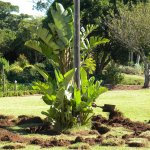
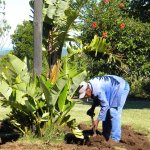
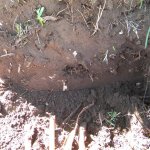
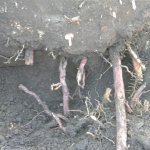


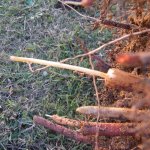
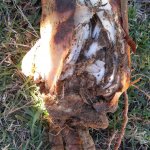

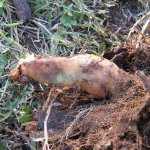
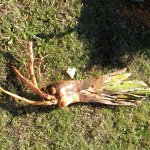



Comments
Strelitzia pruning
We have a very large Strelitzia 4-6m tall and 3m wide.We can't reach the tall branches to prune the dead leaves off. It has new plants shooting from the bottom and so we have considered cutting the tall old trunks. We also worry about them breaking in the SouthE wind, they are so tall and sway a lot in the wind. Do they usually stand-up to the wind and will the plant survive if we cut? It is always full of birds so I don't want to lose it.
Thank you
Pruning Strelitzia nicolai
Hi Liza
It is quite safe (for the plant, that is) to cut down the old trunks. I seldom allow mine to go over 3 meters before I remove them. I do however urge caution when cutting them down. They have a high water content and are unexpectedly heavy. If the trunks are likely to cause damage when they come down, it would be wise to cut them off as high as possible, then cut again at the base. Although pliable, the stems are easily cut. We hack them off with a panga, but if you are not familiar with this tool, rather use a saw. Once the stems are down, it is easy to cut them into pieces for ease of removal.
The trunks will not break unless perhaps in winds of very high, sustained speed, in which case you would be experiencing a hurricane. They are fibrous all the way through, making them very supple.
Strelitzia nicolai would survive even if you cut the whole thing to the ground. Like the banana, the order to which they belong, they have new shoots forming under the ground, which would then sprout.
I really prefer my specimens kept at a lower level, so avoiding the untidy (to me) raggedy dead leaves, while keeping the tropical look.
Do take care though. I wouldn't like to be in the way when the trunks come down.
Kind regards
Lorraine
Thank you.
Thank you
This was very helpful.
Strelitzia is not in the same
Strelitzia is not in the same family as the banana. Tthe former is Strelitziaceae and the latter is Musaceae
Taxonomy
Hi Jenny
Thanks so much for bringing this to my attention. You are quite correct. I have altered the post accordingly, so that it now reads:'...the order to which they belong,...', the order being Zingiberales.
Kind regards
Lorraine
removing and poisoning part of Strelitzia nicolai
I would like to remove some of the clumps and posion these. will this effect the entire clump and what posion should i use.
Poisoning part of Strelitzia nicolai
Hi Angela
My apologies, but I cannot be of much help here. I have little knowledge of which poisons to use as I have not used them for some years now and any knowledge I have is completely out of date.
Strelitzias belong to the same order as banana plants and their structure is very similar, so I Googled 'kill banana tree' and found a number of sites with suggestions and methods of how this can be done. I would think that the same methods could be used for Strelitzias.
As to whether the entire plant would be affected, I came across the following statement:
"To kill the roots of trees and large shrubs a systemic herbicide can be used. It is absorbed by the roots and then translocated to the rest of the plant thereby killing it."
The safest method to remove part of the plant without endangering the entire plant would be to dig out and remove the roots of the unwanted clumps.
Other suggestions:
Contact a tree specialist or tree doctor who may be able to give you more information. Google: 'tree doctor South Africa'
Send your query to the chemical companies who produce the poisons. Efekto has a website where you can send queries: http://efekto.co.za/
I hope you are able to find definitive answers to your questions.
Regards
Lorraine
strelitzia
When (season) do I transplant the strelitzia
Transplanting Strelitzia
Hi Kim
According to PlantZAfrica (http://www.plantzafrica.com/frames/plantsfram.htm), the Kirstenbosch Botanical gardens do this in autumn: "At Kirstenbosch potting/reporting, transplanting and dividing plants happens in autumn. This allows the plant to focus its energy on recovering rather than flowering. Mature plants will normally flower due to stress when divided or transplanted, an inbuilt survival mechanism. Flower stalks can be cut to allow quicker recovery. When dividing mature plants it is important to have a minimum 60 cm clump diameter, so that recovery is faster, more or less two to three years maximum, to full bloom again."
This is a winter rainfall area so the plants have plenty of water through the winter to aid recovery.
In a summer rainfall area you could transplant in autumn and ensure a water supply during winter, or wait until late winter, after the coldest weather has passed.
strelitsia transplant
I have moved and split mine. How much of the leaves do you suggest I remove or cut post transplant?
Leaf removal
Hi Tanya
I usually avoid removing all but the dead, dying, damaged or diseased-looking leaves. Strelitzias seem to need their leaves to aid their recovery.
Kind regards
Lorraine
Strelitzia nicolai
Hi
I had a large Strelitzia nicolai with white and purple flowers. It was growing huge and about to push the fence over so I decided it had to go. I pruned leaves and had it stumped. Will it regrow? It will be a mammoth task to remove the stump.
Regrowth of Strelitzia nicolai
Hi Jenny
Unfortunately, yes, the stump will regrow. The cut stems, unless severely damaged, will usually send up new leaves. Furthermore, there are little buds of new plants attached to the roots underground which will soon replace the removed foliage.
I have never tried poisoning the stump, but you could try painting a tree poison (such as Garlon which is mixed with diesel fuel) onto the freshly cut stems, and wait to see if the plant can be killed this way. You may have to apply this poison more than once.
Kind regards
Lorraine
Dividing Nicolai
Hello Lorraine,
I would very much appreciate your advise on dividing Nicolai: At what age or height should I divide the new shoots, are there any indications to look for before dividing?
Regards,
Dividing Strelitzia
Hi Ceylan
My apologies for not having answered your query.
To be quite honest, I have never taken any special note of size, time of year or age when dividing Strelitzias, other than avoiding doing so during the flowering period.
Kind regards
Lorraine
Use of removed Trunks
Hi there
Do you know if it is safe, after a period of drying out, to burn the Strelitzia trunks we've cut down as firewood? Strange question hey? :-) Just seems like a waste of good combustible material.
Use of removed trunks
Hi Cathy
My abject apologies for not having replied to your query.
I am quite sure it would be safe but I doubt the value of these stems as fire-wood. The stems, like the Strilitzia's relation the banana plant, consist almost entirely of water and by the time the water has dried up, all you are left with is a fibrous mass. I just get the feeling it would be a bit like a grass fire.
Let me know if you tried it.
Kind regards
Lorraine
Thanks for this! I'm going
Thanks for this! I'm going to try them next winter!
Will broken stems shoot new roots?
Hi. I have a giant sterilization and last night after heavy winds and rain, one tall stem snapped and crushed my neighbors fence, Two more tall stems are leaning very precariously now. All about 6 m tall! Will I be able to replant these stems once cut or what would you recommend? Very sad about it!
Wind-damaged Strelitzia
Hi Didar
Unfortunately there is nothing you can do. These stems will definitely not root but new shoots will come up from the root base.
Kind regards
Lorraine
Add new comment